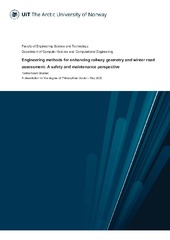| dc.contributor.advisor | Kampffmeyer, Michael C. | |
| dc.contributor.advisor | Chakraborty, Rwiddhi | |
| dc.contributor.author | Sletten, Adrian Henrik de Sena | |
| dc.date.accessioned | 2024-08-23T10:32:28Z | |
| dc.date.available | 2024-08-23T10:32:28Z | |
| dc.date.issued | 2023-08-22 | |
| dc.description.abstract | Shortcut learning, the tendency for models to rely on spurious correlations, is a
widespread issue in deep learning. Although being a known issue, uncovering
the shortcuts present in a dataset can be a difficult task. Over the last few
years, explainability methods have been leveraged to find previously unknown
shortcuts within mainstream datasets. However, how to best mitigate a model’s
reliance on shortcuts, is not a matter that is widely agreed on.
Recently, the concept of group robustness has appeared as a potential way for
mitigating shortcuts. In group robustness, the data in each class is divided
into subclasses where some contain the shortcut features while some other
subclass does not. By optimising a model to increase the worst group performance, the model learns to perform well across groups, mitigating reliance on
shortcuts.
One notable limitation that exists for current group robustness methods is
their reliance on group labels to guarantee performance improvements. The
issue with this is that acquiring these additional labels is a difficult and timeconsuming task. Therefore we propose, eXplainability-based Feature Reweighting (XFR), a group-unsupervised group robustness method. Our proposed
method leverages the clustering of explainability heatmaps to estimate pseudolabels for groups in a dataset and afterwards uses these labels to improve group
robustness.
In our results, we show that XFR clearly improves group robustness compared
to standardly trained models (ERM). We also show that performance is on
par with, and sometimes even surpasses, methods that partially or fully utilise
group labels. | en_US |
| dc.identifier.uri | https://hdl.handle.net/10037/34375 | |
| dc.language.iso | eng | en_US |
| dc.publisher | UiT Norges arktiske universitet | en_US |
| dc.publisher | UiT The Arctic University of Norway | en_US |
| dc.rights.accessRights | openAccess | en_US |
| dc.rights.holder | Copyright 2023 The Author(s) | |
| dc.rights.uri | https://creativecommons.org/licenses/by-nc-sa/4.0 | en_US |
| dc.rights | Attribution-NonCommercial-ShareAlike 4.0 International (CC BY-NC-SA 4.0) | en_US |
| dc.subject.courseID | FYS-3941 | |
| dc.subject | VDP::Technology: 500::Information and communication technology: 550::Computer technology: 551 | en_US |
| dc.subject | VDP::Teknologi: 500::Informasjons- og kommunikasjonsteknologi: 550::Datateknologi: 551 | en_US |
| dc.subject | VDP::Technology: 500::Information and communication technology: 550::Other information technology: 559 | en_US |
| dc.subject | VDP::Teknologi: 500::Informasjons- og kommunikasjonsteknologi: 550::Annen informasjonsteknologi: 559 | en_US |
| dc.subject | VDP::Mathematics and natural science: 400::Physics: 430 | en_US |
| dc.subject | VDP::Matematikk og Naturvitenskap: 400::Fysikk: 430 | en_US |
| dc.subject | VDP::Mathematics and natural science: 400::Information and communication science: 420::Simulation, visualization, signal processing, image processing: 429 | en_US |
| dc.subject | VDP::Matematikk og Naturvitenskap: 400::Informasjons- og kommunikasjonsvitenskap: 420::Simulering, visualisering, signalbehandling, bildeanalyse: 429 | en_US |
| dc.subject | VDP::Mathematics and natural science: 400::Mathematics: 410::Applied mathematics: 413 | en_US |
| dc.subject | VDP::Matematikk og Naturvitenskap: 400::Matematikk: 410::Anvendt matematikk: 413 | en_US |
| dc.subject | VDP::Technology: 500::Information and communication technology: 550::Computer technology: 551 | en_US |
| dc.subject | VDP::Teknologi: 500::Informasjons- og kommunikasjonsteknologi: 550::Datateknologi: 551 | en_US |
| dc.title | Leveraging Explainability Maps for Group-unsupervised Robustness to Spurious Correlations | en_US |
| dc.type | Master thesis | en_US |
| dc.type | Mastergradsoppgave | en_US |


 English
English norsk
norsk



